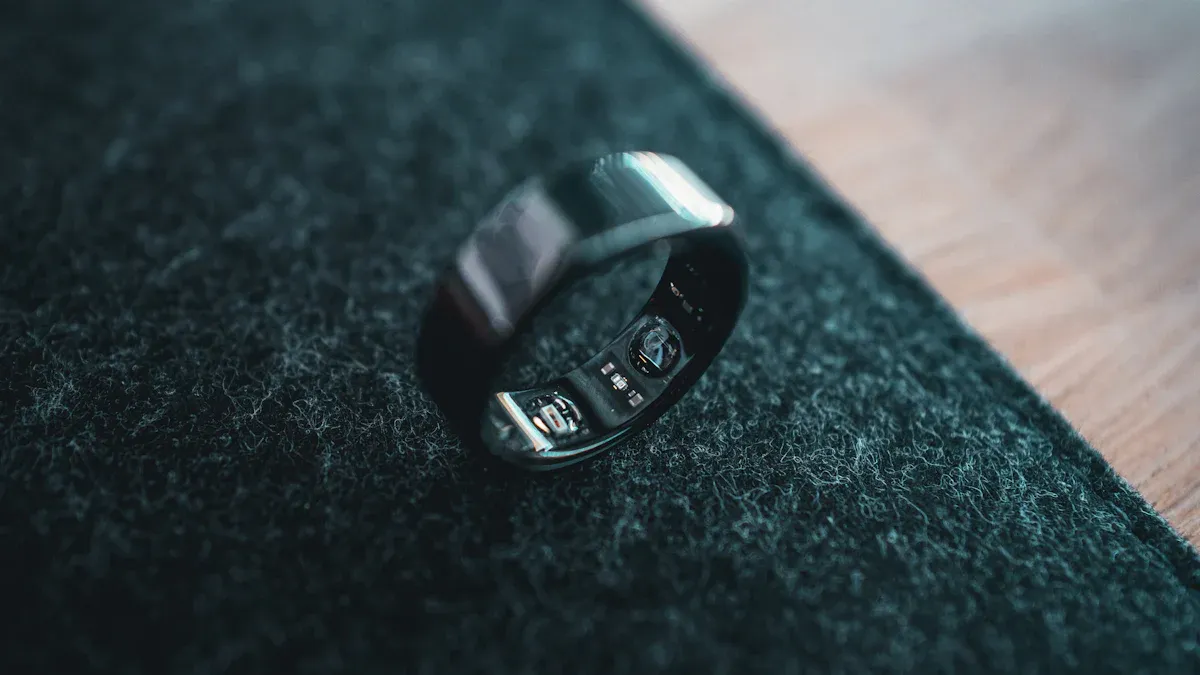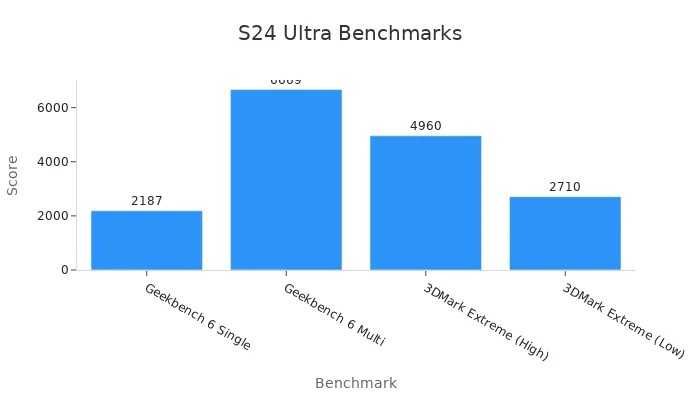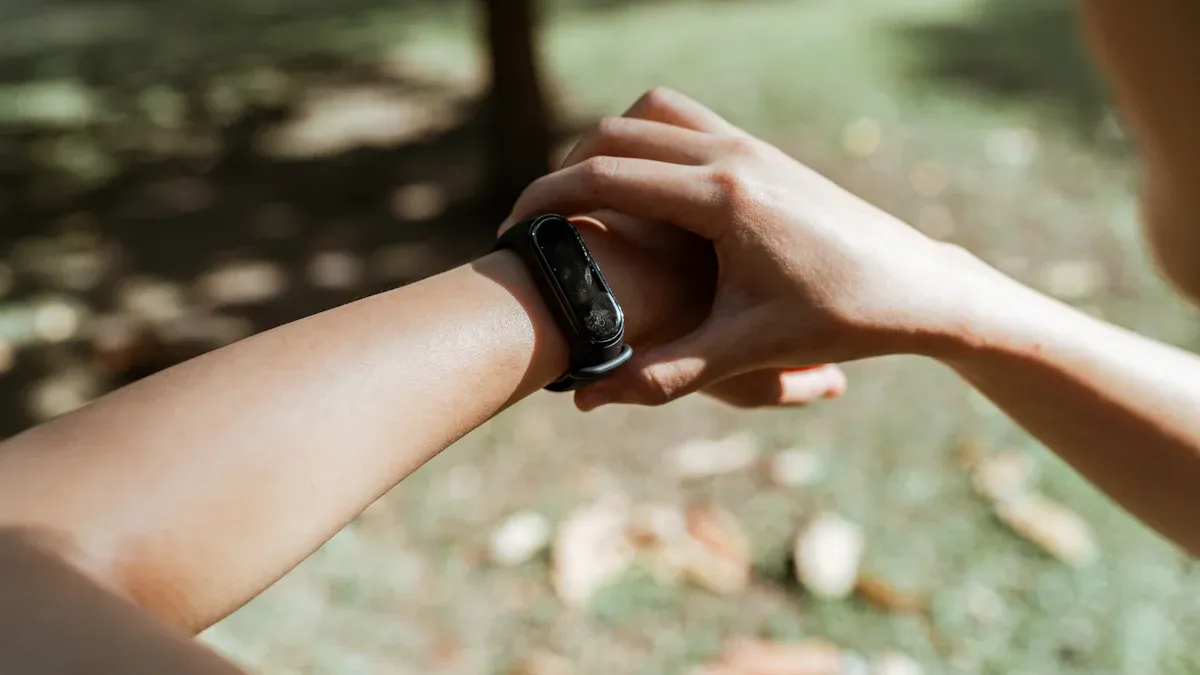
When counting steps, you may wonder which is better: a smart ring or a fitness tracker. A ring step counter is essential for tracking activity, as it helps you monitor your daily movement and achieve your fitness goals. Approximately 60% of people utilize wearable devices for this purpose. Choosing the right one is crucial. Devices like the Apple Watch Series 9 are highly accurate, with an average error of only 3.7 steps. The Oura Ring, a popular option, has a slightly larger error margin of 4.8%. Whether you prefer a ring or a wrist tracker, understanding their accuracy can assist you in making the best choice.
Key Takeaways
-
Smart rings look nice and are comfy, perfect for daily use and basic health tracking.
-
Fitness trackers give more fitness details, like GPS and workout info, great for serious athletes.
-
Step counting accuracy changes; ankle devices are the best, but wrist devices, like fitness trackers, make more mistakes.
-
Think about your habits and needs when picking; smart rings are good for being low-key, while fitness trackers are better for detailed info.
-
Both can help you stay healthy; counting steps daily lowers chances of diseases like diabetes and obesity.
Understanding Smart Rings and Fitness Trackers
What Are Smart Rings?
Smart rings are small devices you wear on your finger. They mix modern technology with stylish looks. These rings can track health, make payments, and monitor sleep. Sensors in the ring measure things like heart rate, temperature, and oxygen levels. Wearing them on your finger helps get accurate readings. This makes them popular with people who care about their health.
The smart ring market is growing fast. By 2025, it might be worth $59 million in the U.S. This growth is due to better tiny electronics and sensors. These improvements let rings have many features in a small size. People like smart rings because they are small and can track health without being obvious.
What Are Fitness Trackers?
Fitness trackers are worn on your wrist to track activity and health. They are great for counting steps, calories, and heart rate. They also monitor sleep and show data on bigger screens. This makes it easy to check your progress.
The fitness tracker market is expanding quickly. In 2022, it was worth $61.30 billion and could grow to $290.85 billion by 2032. Many people use them for running and biking, with 40% relying on them for these activities. Their popularity comes from giving detailed fitness data to help you meet health goals.

Key Differences in Design and Functionality
Smart rings and fitness trackers are different in design and use. Smart rings focus on comfort and style, so you can wear them all day. They are small and good for quiet health tracking. But they don’t track fitness as well as bigger devices. Fitness trackers give more detailed data with bigger screens and advanced tools.
Smart rings are great for checking heart rate and temperature because of their finger placement. Fitness trackers offer more features like GPS and workout tracking. Smart rings are for people who want simple health tracking. Fitness trackers are for those who want detailed fitness data and live updates.
Step Counting Accuracy: Ring Step Counter vs Fitness Trackers
How Smart Rings Track Steps
Smart rings use special tools to count steps and track activity. For example, the Oura Ring uses sensors like gyroscopes, accelerometers, and PPG sensors. These sensors work together to measure movement and count steps. The accelerometer notices motion changes, while the gyroscope tracks direction and rotation. The PPG sensor adds heart rate and energy level data. Together, they give a clear view of your activity.
Wearing a smart ring on your finger helps it track better. Finger movements often match your body’s natural motion, making step counting easier. This design lets smart rings track steps and give health insights. If you want a stylish and simple tracker, a smart ring could be perfect.
How Fitness Trackers Track Steps
Fitness trackers use a 3-axis accelerometer to track movement. This sensor measures motion in all directions to find walking or running patterns. The data is processed by software that calculates step counts. It can also tell if you’re standing, walking, or jogging.
Fitness trackers show this data on a screen or app. The app gives extra details like speed, pace, and calories burned. Studies show fitness trackers work best at normal walking speeds. They are more accurate when worn on the ankle or thigh. Still, wrist trackers are most popular because they are easy to use and have many features.
Comparing Sensor Technology in Smart Rings and Fitness Trackers
Both smart rings and fitness trackers use similar sensors, but their designs differ. Smart rings combine many sensors in a small, stylish design. Their finger placement improves heart rate and step tracking. Fitness trackers often have bigger sensors and extra features like GPS. They are great for detailed fitness tracking, especially during workouts.
Studies show wrist trackers have more errors than devices worn elsewhere. Even so, fitness trackers are very good at counting steps and tracking fitness. Smart rings are more subtle and stylish, making them great for people who want both accuracy and good looks.
Real-World Accuracy: Studies and User Feedback
Both smart rings and fitness trackers have pros and cons. Studies and user reviews help us see how well they work daily.
Accuracy in Step Counting
Step counting accuracy depends on the device and where it’s worn. Research shows ankle or thigh devices are most accurate, with only 1% error. Wrist devices, like fitness trackers, have a higher error rate of 15%. Smart rings, worn on fingers, are usually in the middle.
|
Device |
MAPE (Mean Absolute Percentage Error) |
|---|---|
|
Ankle and Thigh |
1% |
|
Waist |
3% |
|
Wrist |
15% |
|
Overall (normal speeds) |
7% |
|
Overall (slow speeds) |
40% |

User Feedback on Smart Rings and Fitness Trackers
Users like smart rings for comfort and tracking sleep and energy. The Oura Ring is known for its health tracking and step accuracy. Fitness trackers are better for detailed data like speed and pace, great for workouts.
|
Device |
Steps |
Sleep |
Heart Rate |
Caloric Expenditure |
|---|---|---|---|---|
|
Apple Watch |
3% |
0.91% |
115% |
|
|
Oura Ring |
4.8% |
6% |
3% |
13% |
|
Fitbit |
21.9% |
13% |
N/A |
14.8% |
|
Garmin |
23.7% |
2% |
1.39% |
42.9% |
Smart rings are loved for their simple design and overall health tracking. Fitness trackers are best for people who want detailed activity data.
Additional Features of Fitness Tracking Wearables

Comfort and Wearability
Comfort is important when picking a fitness tracker. You’ll wear it for long hours, so it should feel good. Lightweight devices like the Fitbit Inspire 3 and Whoop 4.0 are very comfy. They score 9 out of 10 for wearability. Bigger trackers, like the Garmin Forerunner 965, are less comfy. They only score 5 out of 10.
Smart rings, like the Oura Ring Gen 3, are also very comfortable. Their small size makes them easy to wear all day. If comfort matters to you, choose devices with high ratings and good designs.

Battery Life and Charging
Battery life is key when choosing a fitness tracker. Longer battery life means less charging. The Oura Ring Gen 3 lasts up to 7 days per charge. The Ultrahuman Ring Air works for 3–4 days. Fitness trackers like the Fitbit Charge 6 can last 10 days, which is great for long use.
Charging speed is also important. Most devices take 1–2 hours to fully charge. If you’re busy, quick charging saves time. Long battery life and fast charging help you track health without interruptions.

Design and Aesthetics
The look of a fitness tracker affects how you feel wearing it. Sleek designs, like the Oura Ring Gen 3, match well with daily outfits. A good design can show your style and personality.
Fitness trackers often have colorful screens and changeable bands. This makes them fit different occasions. Smart rings are simpler and focus on being elegant. Whether you like bold or simple designs, pick one that fits your style and needs.
Cost and Value for Money
When picking between smart rings and fitness trackers, knowing their cost and value is helpful. Both have special features, but their prices and benefits differ a lot.
Smart rings, like the Vertu AI Diamond Ring – Prajna Edition, mix style and tech. They cost $660 and offer advanced health tools like blood sugar tracking and sleep monitoring. These rings also last long, look great, and are waterproof. Though pricey, they combine usefulness and beauty, making them worth it for some users.
Fitness trackers are for more people and come in many price ranges. Cheaper ones, like the Fitbit Inspire 3, cost about $100 and track basic activities and sleep. Expensive ones, like the Garmin Forerunner 965, can cost over $500 and include GPS and workout details. Fitness trackers often have bigger screens and changeable bands for ease and style.
Think about what matters most to you. If you want small, high-tech wearables, smart rings are a good pick. If you need detailed fitness info and lower prices, fitness trackers are better. Both are great for tracking sleep, no matter your budget.
In the end, the best choice depends on your needs. Comparing features and costs helps you find the right device for your lifestyle.
Limitations of Smart Rings and Fitness Trackers
Problems with Ring Step Counters
Smart rings are cool but have some problems. Their small size means fewer sensors can fit inside. This can make step counting less accurate, especially during fast activities. For example, quick hand movements that aren’t walking might confuse the sensors. This could lead to wrong step counts. Also, wearing the ring on your finger might miss small movements compared to wrist devices.
Things like sweat, dirt, or skin issues can also cause problems. These can block the sensors and make step tracking less accurate. Even with these issues, many people like smart rings for their style and simplicity over detailed fitness tracking.
Issues with Fitness Trackers
Fitness trackers are popular but not perfect. They often guess heart rate and calories wrong, which can mislead your progress. Studies show they miss about 9% of steps and often overestimate sleep. For example, they might say you slept 10% longer than you did. They also miss times you wake up during the night.
|
Problem |
What Happens |
|---|---|
|
Heart rate errors |
Fitness trackers often guess heart rate too low. |
|
Calorie tracking mistakes |
They usually underestimate how many calories you burn. |
|
Accuracy issues |
Things like exercise type, wrist position, and skin can affect results. |
|
Step count errors |
They miss about 9% of steps on average. |
|
Sleep tracking mistakes |
They overestimate sleep time by 10% and miss wake times. |
|
Aerobic capacity errors |
They overestimate VO2max by 15% at rest and 10% during exercise. |
These mistakes show why it’s important to know your device’s limits. This helps you set better fitness goals.
When Both Devices Struggle
Both smart rings and fitness trackers have trouble in certain situations. High-energy exercises like sprinting or lifting weights can confuse the sensors. This makes step counts and heart rate tracking less accurate. Sweat, dirt, or wrist position can also mess up the readings.
|
Cause of Problem |
How It Affects Accuracy |
|---|---|
|
Intense exercise |
Makes tracking less accurate |
|
Moving arms a lot |
Confuses the sensors |
|
Wrist position |
Lowers accuracy |
|
Sweat or dirt |
Blocks sensors |
|
Skin color |
Can reduce accuracy |
Knowing these problems helps you use these devices better. They give useful info but aren’t perfect. You might need to adjust settings or use other tools for more accurate tracking.
Smart Ring vs Smartwatch: Which Device Should You Choose?
Best for Simple Activity Tracking
If you want to track steps and basic health, both smart rings and smartwatches work well. Smart rings are simple and comfortable. They are light, easy to wear, and not bulky. This makes them great for people who want easy tracking without a big device.
-
About 60% of wearable users track steps, but devices miss 9%.
-
Rings on fingers are easier to use than wrist devices.
-
They also last longer and store more data than some trackers.
Smartwatches have bigger screens and show more details. If you like quick updates on a screen, a smartwatch might be better. Think about how much info you need and how often you’ll check it.
Best for Fitness Fans
Fitness fans often prefer smartwatches. They have GPS, workout modes, and live performance stats. These features help track progress and improve training. Athletes use them to measure heart rate, speed, and other data.
-
Smartwatches track sleep, body temperature, and breathing.
-
This info helps you see how well your workouts work.
-
They also lower injury risks by checking for body strain.
Smart rings are stylish but don’t track as much detail. They are good for light activity tracking but not for serious fitness goals.
Best for Tech Lovers
If you like new tech, both devices are exciting. Smart rings mix style with advanced features. They have NFC for payments and Bluetooth for connecting to devices. Their sleek look is great for people who want a trendy gadget.
|
Feature |
Why Users Like It |
How It Improves Experience |
|---|---|---|
|
Health Tracking |
Matches health trends, making users happy |
|
|
Contactless Payments |
NFC lets you pay quickly and easily |
Offers fast, clean payment options, boosting user satisfaction |
|
Stylish Looks |
Cool designs that fit many styles |
Attracts users who want both function and fashion |
Smartwatches are more flexible. They combine apps, notifications, and fitness tools in one device. When choosing, think about whether you want style or more features. Tech lovers enjoy the cool innovations both devices offer.
When picking between smart rings and fitness trackers, think about what works best for you. Each has its own advantages:
-
Step Counting Accuracy: Devices worn on ankles or thighs are the most precise. Wrist devices make more mistakes, but smart rings are fairly accurate and very comfy to wear.
-
Additional Features: Fitness trackers give detailed fitness stats, while smart rings mix health tracking with stylish looks.
Walking more steps daily can reduce risks of diseases like diabetes and obesity. Tracking steps is a great way to stay healthy.
In the end, your decision depends on your habits, budget, and what you like. Both options can help you stay fit and reach your health goals.
FAQ
How good are smart rings at counting steps?
Smart rings are pretty accurate for counting steps. They use advanced tools to track your natural movements. While not as exact as ankle devices, they work well for daily walking.
Can fitness trackers tell how many calories you burn?
Fitness trackers guess calories burned using your activity and heart rate. They give helpful info but aren’t always exact. Use them as a rough guide, not a perfect number.
Are smart rings good for tracking sleep?
Yes, smart rings are great for tracking sleep. They check your heart rate, temperature, and movement to study your sleep. This helps you learn about your rest and improve it.
Which is better for long walks?
Fitness trackers are better for long walks. They show details like distance, speed, and calories burned. Smart rings are good but don’t give as much info for long activities.
Are smart rings comfy to wear every day?
Smart rings are small and light, making them comfy all day. They are great for people who want simple and hidden health trackers.








